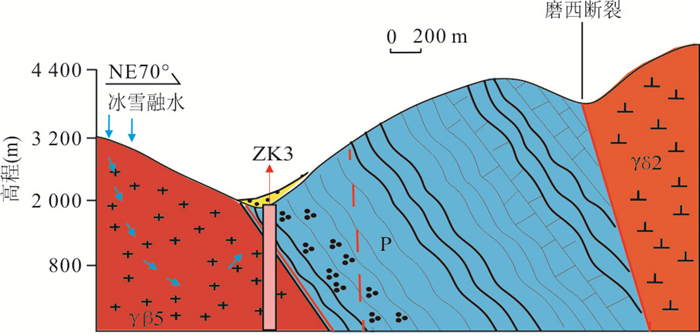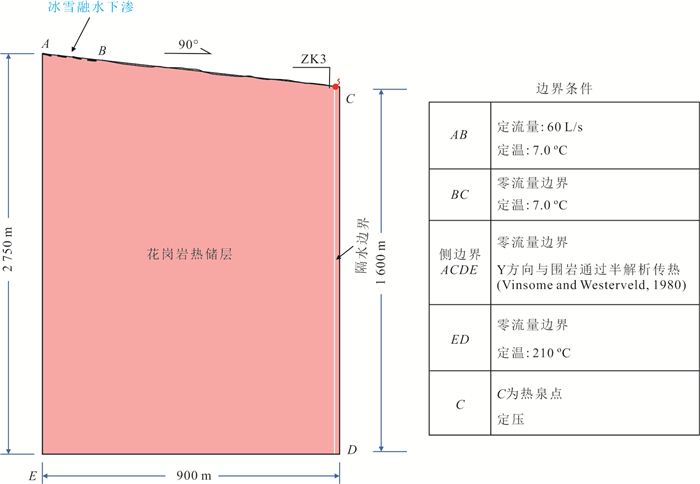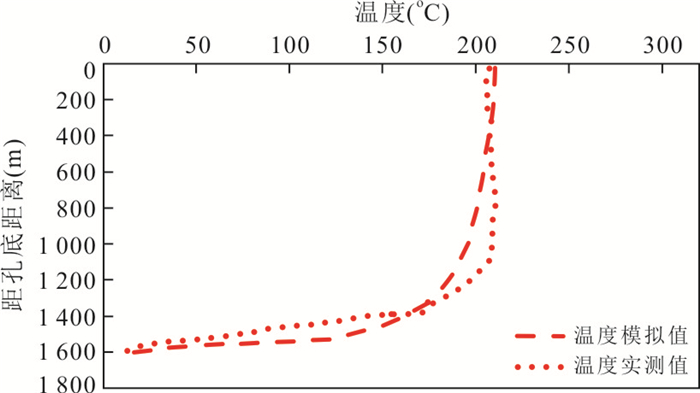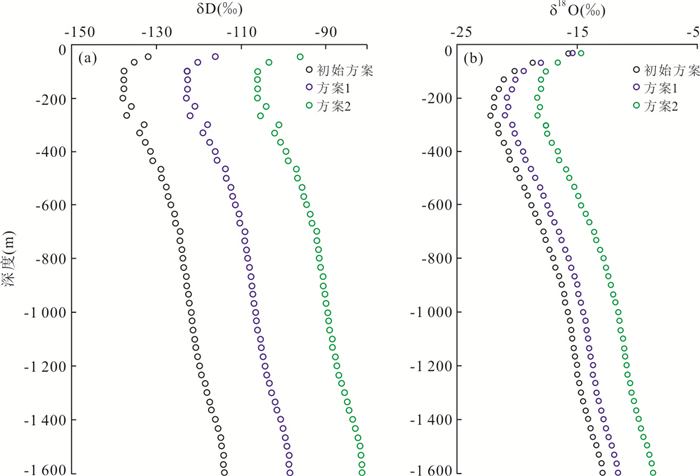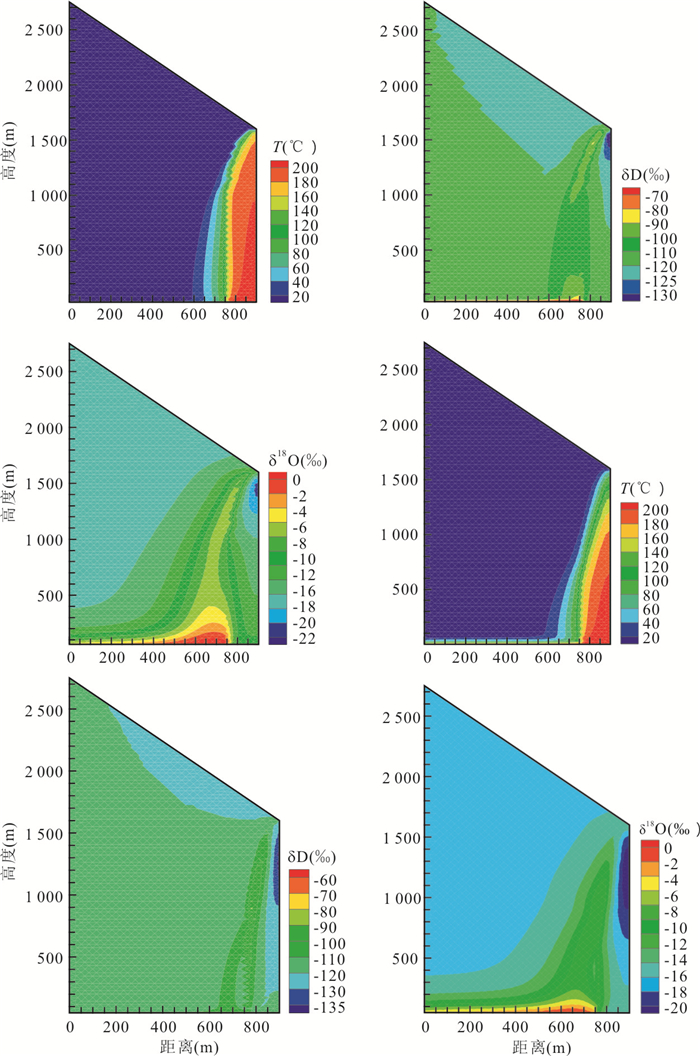Numerical Modelling of Stable Isotope Transport Processes in a Hydrogeothermal System of Kangding-Laoyuling Area
-
摘要: 以康定老榆林地区地热系统为研究对象,利用TOUGH-Isotope程序进行水-热-同位素耦合数值模拟,并鉴于研究区大气降水氢氧同位素季节性明显、地震活动活跃,探讨了补给水同位素特征、热储层渗透性变化对地热系统氢氧同位素迁移过程的影响.研究结果表明氢氧同位素模拟值与研究区ZK3钻孔流出水测试值基本拟合,高温地热系统的对流-弥散作用对氢氧同位素迁移过程影响明显;研究区地热水循环条件较好,水-岩作用程度较低,导致氧同位素重化现象不明显;补给水同位素特征、热储层渗透性两个因素对地热水循环过程中的氢氧同位素分布具有明显的影响.开展地热系统流体氢氧同位素迁移过程研究,有助于提高对地热系统动态演化的定量化认识,为地热开发提供支持.Abstract: In Laoyulin geothermal system of Kangding, we uses TOUGH-Isotope program to conduct the numerical simulation of water-heat-isotope coupling. In view of the obvious seasonality of stable isotopes in precipitation and active seismic activity in the research area, the impact that the isotope characteristics of recharge water and thermal reservoir permeability variation on the transport of hydrogen and oxygen isotopes in the geothermal system also are explored in this paper. The results indicate that the calculate values of hydrogen and oxygen isotopes of the hot water are generally with the measured values in ZK3 borehole, and the convection-dispersion effect of the high-temperature geothermal system has a significant effect on the migration process of hydrogen and oxygen isotopes. The geothermal water circulation conditions in the study area are strong, which causes the phenomenon of oxygen isotope enrichment to be slight. In the geothermal water circulation, the two factors-isotope characteristics of recharge water and thermal reservoir permeability have significant effects on the distribution of hydrogen and oxygen isotopes. Therefore, the numerical modelling of stable isotope transport processes in the geothermal system fluid can help to improve the quantitative understanding of the dynamic evolution of the geothermal system, which will provide support for geothermal development.
-
图 2 老榆林地热系统地质概况
Fig. 2. Conceptual model of geothermal flow along the Laoyulin geothermal system
表 1 实验获取的模型方程及相关常数设置
Table 1. Experimental equations and parameter setting in the model
实验获取的方程 相关系数取值 主要参数计算值(K)
278.15 < T < 573.15参考文献 $ \begin{array}{l}{10}^{3}\mathrm{l}\mathrm{n}{\alpha }_{l-v}=\frac{a{T}^{3}}{{10}^{9}}+\frac{b{T}^{2}}{{10}^{6}}+\frac{cT}{{10}^{3}}\\ +d+\frac{e{10}^{9}}{{T}^{3}}\end{array} $ a=1 158.8, b=-1 620.1, c=794.84, d=-161.04, e=2.999 2
for HDO0.905 7~0.996 6, - Horita and Wesolowski(1994) $ {10}^{3}\mathrm{l}\mathrm{n}{\alpha }_{l-v}=\frac{{10}^{9}a}{{T}^{3}}+\frac{{10}^{6}b}{{T}^{2}}+\frac{{10}^{3}c}{T}+d $ a=0.350 41, b=-1.66 64, c=6.712 3, d=-7.685 0
for H218O0.988 8~0.997 6, - $ D={10}^{-9}{a}_{i}\mathrm{e}\mathrm{x}\mathrm{p}(\frac{a}{{T}^{2}}+\frac{b}{T}+c) $ a=-535 400, b=1 393.3,
c=2.187 6,
ai=0.983 3
for HDO
ai=0.966 9
for H218O1.29×10-9~19.50×10-9 for HDO, +
1.27×10-9~19.20×10-9 for H218O, +Braud et al.(2005); Merlivat(1978); Shurbajia et al.(1995) $ \mathrm{l}\mathrm{o}\mathrm{g}\left({k}_{rl}\right)=\mathrm{l}\mathrm{o}\mathrm{g}\left({A}_{0}\right)+{E}_{a}/2.3RT $ A0=9.0×10-15 1/s,
Ea=200 kJ /mol,
R=8.314 56 kJ/(mol·K)
for H218O and granite6.78×10-13~7.09×10-13, - Cole and Chakraborty(2001) -
Bian, Y.Y., Zhao, D., 2018. Genesis of Geothermal Waters in the Kangding Geothermal Field, Sichuan Province. Acta Geoscientica Sinica, 39 (04): 109-115(in Chinese with English abstract). http://www.zhangqiaokeyan.com/academic-journal-cn_acta-geoscientica-sinica_thesis/0201253090856.html Braud, I., Bariac, T., Gaudet, J. P., et al., 2005. SiSPAT-Isotope, a Coupled Heat, Water and Stable Isotope (HDO and H218O) Transport Model for Bare Soil. Part I. Model Description and First Verifications. Journal of Hydrology, 309(1/2/3/4): 277-300. https://doi.org/10.1016/j.jhydrol.2004.12.013 Brikowski, T. H., 2001. Deep Fluid Circulation and Isotopic Alteration in the Geysers Geothermal System: Profile Models. Geothermics, 30(2/3): 333-347. https://doi.org/10.1016/s0375-6505(00)00055-9 Chen, Z., Du, J. G., Zhou, X., et al., 2014. Hydrochemistry of the Hot Springs in Western Sichuan Province Related to the Wenchuan MS8.0 Earthquake. The Scientific World Journal, 2014(5220): 1-13. https://doi.org/10.1155/2014/901432 Cole, D. R., Ohmoto, H., Lasaga, A. C., 1983. Isotopic Exchange in Mineral-Fluid Systems. I. Theoretical Evaluation of Oxygen Isotopic Exchange Accompanying Surface Reactions and Diffusion. Geochimica et Cosmochimica Acta, 47(10): 1681-1693. https://doi.org/10.1016/0016-7037(83)90018-2 Cole, D. R., Mottl, M. J., Ohmoto, H., 1987. Isotopic Exchange in Mineral-Fluid Systems. II. Oxygen and Hydrogen Isotopic Investigation of the Experimental Basalt-Seawater System. Geochimica et Cosmochimica Acta, 51(6): 1523-1538. https://doi.org/10.1016/0016-7037(87)90334-6 Cole, D. R., Chakraborty, S., 2001. Rates and Mechanisms of Isotopic Exchange. Reviews in Mineralogy and Geochemistry, 43(1): 83-223. https://doi.org/10.2138/gsrmg.43.1.83 Fekete, S., Weis, P., Scott, S., et al., 2018. Multiple Stable Isotope Fronts during Non-Isothermal Fluid Flow. Geochimica et Cosmochimica Acta, 223: 537-557. https://doi.org/10.1016/j.gca.2017.12.009 Gregory, R. T., Criss, R. E., Taylor, H. P. Jr, 1989. Oxygen Isotope Exchange Kinetics of Mineral Pairs in Closed and Open Systems: Applications to Problems of Hydrothermal Alteration of Igneous Rocks and Precambrian Iron Formations. Chemical Geology, 75(1/2): 1-42. https://doi.org/10.1016/0009-2541(89)90019-3 Guo, Q., Pang, Z. H., Wang, Y. C., et al., 2017. Fluid Geochemistry and Geothermometry Applications of the Kangding High-Temperature Geothermal System in Eastern Himalayas. Applied Geochemistry, 81(4): 63-75. https://doi.org/10.1016/j.apgeochem.2017.03.007 Horita, J., Wesolowski, D. J., 1994. Liquid-Vapor Fractionation of Oxygen and Hydrogen Isotopes of Water from the Freezing to the Critical Temperature. Geochimica et Cosmochimica Acta, 58(16): 3425-3437. https://doi.org/10.1016/0016-7037(94)90096-5 Hou, Z.Y., 2019. Characterizing the Geothermal System in the Gonghe-Guide Basin by Coupled Fluid-Heat-Chemical (Isotope) Transport Modeling. Jilin University, Changchun(in Chinese). Jiang, Z. J., Xu, T. F., Mallants, D., et al., 2019. Numerical Modelling of Stable Isotope (2H and 18O) Transport in a Hydro-Geothermal System: Model Development and Implementation to the Guide Basin, China. Journal of Hydrology, 569(1-4): 93-105. https://doi.org/10.1016/j.jhydrol.2018.11.065 Li, B., Shi, Z. M., Wang, G. C., et al., 2019. Earthquake-Related Hydrochemical Changes in Thermal Springs in the Xianshuihe Fault Zone, Western China. Journal of Hydrology, 579(3): 124175. https://doi.org/10.1016/j.jhydrol.2019.124175 Li, X., Wang, J.J., Huang, X., et al., 2018. Chemical and Isotopic Characteristics of Hot Water in the Kangding-Daofu Section of Xianshuihe Fault Zone, Sichuan, China. Journal of Chengdu University of Technology(Science & Technology Edition), 45(6): 733-745(in Chinese with English abstract). http://www.researchgate.net/publication/331332157_Chemical_and_isotopic_characteristics_of_hot_water_in_the_Kangding-Daofu_section_of_Xianshuihe_fault_zone_Sichuan_China Li, Y.Y., Li, X., 2019. Exposed Characteristics of Underground Hot Water In Erdaoqiao To Yulingong Area, Kangding. Journal of Geological Hazards and Environment Preservation, 30(1): 106-112(in Chinese with English abstract). http://en.cnki.com.cn/Article_en/CJFDTotal-DZHB201901020.htm Liu, M.L., He, T., Wu, Q.F., 2019. Hydrogeochemistry of Geothermal Waters from the Xiong'an New Area and Its Indicating Significance. Earth Science, 45(6): 2222-2231 (in Chinese with English abstract). Luo, J., Pang, Z. H., Kong, Y. K., et al., 2017. Geothermal Potential Evaluation and Development Prioritization Based on Geochemistry of Geothermal Waters from Kangding Area, Western Sichuan, China. Environmental Earth Sciences, 76(9): 1-24. https://doi.org/10.1007/s12665-017-6659-9 Ma, Z.Y., Yu, J., Li, Q., 2008. Environmental Isotope Distribution and Hydrologic Geologic Sense of Guanzhong Basin Geothermal Water. Journal of Earth Sciences and Environment, 30(4): 396-401(in Chinese with English abstract). http://en.cnki.com.cn/Article_en/CJFDTOTAL-XAGX200804014.htm Merlivat, L., 1978. Molecular Diffusivities of H216O, HD16O, and H218O in Gases. The Journal of Chemical Physics, 69(6): 2864. https://doi.org/10.1063/1.436884 Norton, D., Taylor, J.H., 1979. Quantitative Simulation of the Hydrothermal Systems of Crystallizing Magmas on the Basis of Transport Theory and Oxygen Isotope Data: An Analysis of the Skaergaard Intrusion. Journal of Petrology, 20 (3): 421-486. doi: 10.1093/petrology/20.3.421 Pang, Z. H., Kong, Y. L., Li, J., et al., 2017. An Isotopic Geoindicator in the Hydrological Cycle. Procedia Earth and Planetary Science, 17(4): 534-537. https://doi.org/10.1016/j.proeps.2016.12.135 Qi, J. H., Xu, M., An, C. J., et al., 2017. Characterizations of Geothermal Springs along the Moxi Deep Fault in the Western Sichuan Plateau, China. Physics of the Earth and Planetary Interiors, 263(2): 12-22. https://doi.org/10.1016/j.pepi.2017.01.001 Qian, H., 2005. Hydrogeochemistry. Geology Press, Beijing(in Chinese). Shurbajia, A. R. M., Phillips, F. M., Campbella, A. R., et al., 1995. Application of a Numerical Model for Simulating Water Flow, Isotope Transport, and Heat Transfer in the Unsaturated Zone. Journal of Hydrology, 171(1/2): 143-163. https://doi.org/10.1016/0022-1694(95)02756-f Song, C.L., Sun, X.Y., Wang, G. X, et al., 2015. A Study on Precipitation Stable Isotopes Characteristics and Vapor Sources of The Subalpine Gongga Mountain, China. Resources and Environment in the Yangtze Basin, 24(11): 1860-1869(in Chinese with English abstract). http://www.researchgate.net/publication/292476132_A_STUDY_ON_PRECIPITATION_STABLE_ISOTOPES_CHARACTERISTICS_AND_VAPOR_SOURCES_OF_THE_SUBALPINE_GONGGA_MOUNTAIN_CHINA Song, X.Q., Peng, Q., Duan, Q.B., et al., 2019. Hydrochemical Characteristics and Origin of Geothermal Water in Northeastern Guizhou. Earth Science, 44(9): 2875-2886 (in Chinese with English abstract). Yin, G., Wang, X.D., Gao, Z.Y., et al., 2008. Study of the Hydrology of Glacial Runoff in Hailuogou Valley, Gongga Mountain by Means of Isotopic Tracing. Journal of Glaciology and Geocryology, (3): 365-372(in Chinese with English abstract). http://en.cnki.com.cn/Article_en/CJFDTotal-BCDT200803001.htm Zhang, Y.H., 2018. Research on Genesis and Development of the Geothermal System in the Kangding-Moxi Segment of the Xianshuihe Fault(Dissertation). Chengdu University of Technology, Chengdu(in Chinese with English abstract). Zhang, Z.G., Li, J., Tian, Z.H., 2009. Investigation and Evaluation of Geothermal Resources of Shattered Fractures Zones in Mountainous Areas of Xiaoreshui, Kangding. Journal of Hebei University of Technology, 48(3): 93-96(in Chinese with English abstract). http://en.cnki.com.cn/Article_en/CJFDTotal-HBGB201903015.htm Zheng, Y. F., 1993. "Calculation of Oxygen Isotope Fractionation in Anhydrous Silicate Minerals. " Geochimica et Cosmochimica Acta, 57(13): 3199. https://doi.org/10.1016/0016-7037(93)90306-h 卞跃跃, 赵丹, 2018. 四川康定地热田地下热水成因研究. 地球学报, 39 (4): 109-115. https://www.cnki.com.cn/Article/CJFDTOTAL-DQXB201804012.htm 侯兆云, 2019. 基于流体渗流-化学(同位素)耦合模拟的共和-贵德地热储层特征分析(博士学位论文). 长春: 吉林大学. 李晓, 王金金, 黄珣, 等, 2018. 鲜水河断裂带康定至道孚段热水化学与同位素特征. 成都理工大学学报: 自然科学版, 45(6): 733-745. doi: 10.3969/j.issn.1671-9727.2018.06.09 李玥樾, 李晓, 2019. 康定二道桥-榆林宫地区地下热水出露特征. 地质灾害与环境保护, 30(1): 106-112. https://www.cnki.com.cn/Article/CJFDTOTAL-DZHB201901020.htm 刘明亮, 何曈, 吴启帆, 等, 2019. 雄安新区地热水化学特征及其指示意义. 地球科学, 45(6): 2222-2231. doi: 10.3799/dqkx.2019.270 马致远, 余娟, 李清, 等, 2008. 关中盆地地下热水环境同位素分布及其水文地质意义. 地球科学与环境学报, 30(4): 396-401. doi: 10.3969/j.issn.1672-6561.2008.04.011 钱会, 2005. 水文地球化学. 北京: 地质出版社. 宋春林, 孙向阳, 王根绪, 等, 2015. 贡嘎山亚高山降水稳定同位素特征及水汽来源研究. 长江流域资源与环境, 24(11): 1860-1869. doi: 10.11870/cjlyzyyhj201511008 宋小庆, 彭钦, 段启杉, 等, 2019. 黔东北地区地热水化学特征及起源. 地球科, 44(9): 2875-2886. https://www.cnki.com.cn/Article/CJFDTOTAL-DQKX201909006.htm 尹观, 王小丹, 高志友, 等, 2008. 贡嘎山海螺沟冰川径流水文规律的同位素示踪研究. 冰川冻土, (3): 365-372. https://www.cnki.com.cn/Article/CJFDTOTAL-BCDT200803001.htm 张云辉, 2018. 鲜水河断裂康定-磨西段地热系统成因及开发利用研究(博士学位论文). 成都: 成都理工大学. 张志刚, 李郡, 田自浩, 2009. 康定小热水地区山区断裂破碎带地热资源勘查与评价. 河北工业大学学报, 48(3): 93-96. https://www.cnki.com.cn/Article/CJFDTOTAL-HBGB201903015.htm -









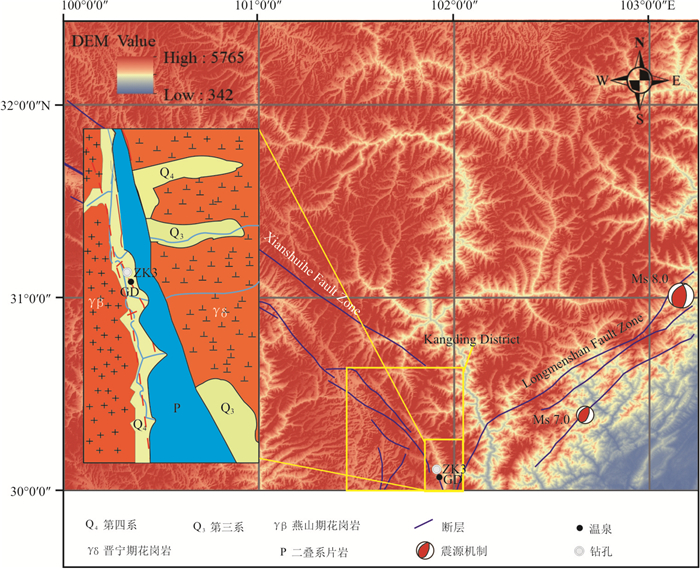
 下载:
下载:
